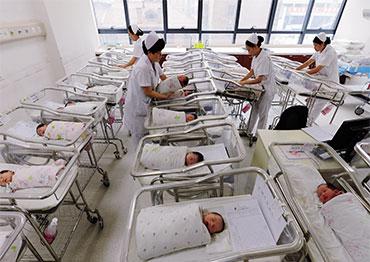Liang Jianzhang, an economics professor and demographer at Peking University and CEO and cofounder of travel site Ctrip, said China is only spending 1 percent of GDP on childbearing-related expenditure, which is far below what is necessary to address its demographic crisis.
In a widely shared article published on social media in May, Liang compared public expenditure on childbearing-related benefits and fertility rates in some 20 developed countries, and found that to boost the fertility rate by 0.1 would require additional expenditure of 1 percent of a country’s GDP.
Liang concluded that China needs to spend 2 percent of its GDP to improve its fertility rate to the level of Japan, 5 percent to the average level of developed countries or 10 percent to raise the fertility rate to the replacement level of 2.1.
Regarding the issue of affordability, with one of the world’s highest savings rates, China is well-positioned to substantially increase spending on boosting fertility. In past years, China has made colossal investments on infrastructure such as roads and railways, and as needs in these areas are saturated, China should shift its investment focus to supporting families, Liang said.
While debate continues about how far China should go to with its “supportive measures,” the current consensus is that childcare facilities need to be built and subsidized by the government.
Song said that China used to have a robust State-funded childcare system under the planned economy until it disintegrated in the 1990s as a result of economic liberalization. Since then, the cost of childrearing was handed over to families.
According to survey data released by the National Health Commission of China, among China’s 40 to 50 million children under 3, only about 5 percent have access to childcare facilities, with the majority primarily taken care of by family members, often seniors. “It is very clear that Chinese families have now become overwhelmed with that burden,” Song said, “It is time for the State to shoulder that responsibility again.”
For He Yafu, the underlining problem with China’s low fertility rate is that Chinese society has increasingly become hostile toward would-be parents. Children are often perceived as a liability rather than an asset.
Besides lowering childbearing costs and offering financial support, He said that a major policy focus should be on the protection and promotion of women’s career opportunities. For a long time, Chinese women have struggled with workplace discrimination often based on their marital and parental status. Many experts believe this is one of the biggest factors behind China’s falling fertility rate.
It was reported that in order to encourage couples to have more children, the government is considering to increase the length of parental leave, although this could lead to a worse situation for working women. According to He, the government should opt to subsidize parental leave and offer tax rebates to employers based on the ratio of their female workers.
“The fundamental question for policymakers is how to make Chinese society more child-friendly,” He said.

 Old Version
Old Version

